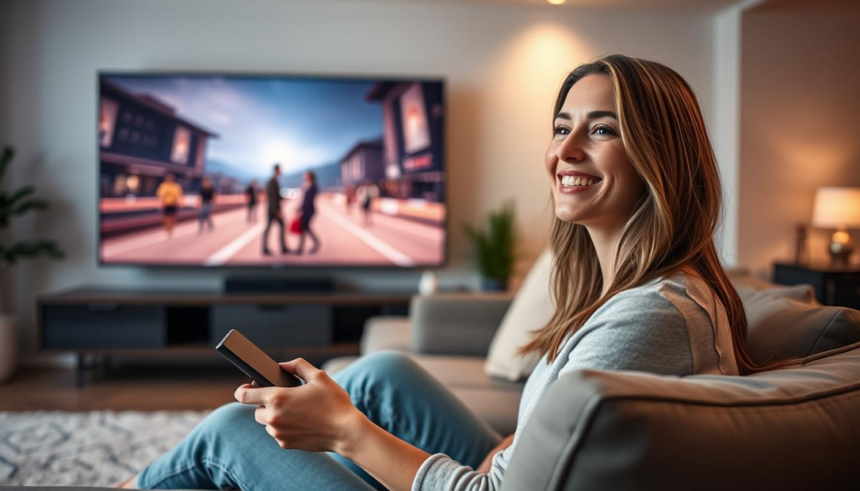From Pixels to Perfection: How Television Tech Evolved to Shape Modern Entertainment
The journey of television technology is truly fascinating. It has changed how we watch visual entertainment. From mechanical beginnings to today’s digital wonders, TV tech has greatly influenced how we enjoy media.
- The Birth of Television: From Mechanical to Electronic Systems
- Mechanical Television Systems and Their Limitations
- The Revolutionary Electronic Television
- Early Broadcasting Milestones
- The Color Revolution: Transforming Viewing Experiences
- Digital Television: The Shift from Analog to Binary
- The Benefits of Digital Broadcasting
- Digital Signal Processing Innovations
- Compression Technologies and Their Impact
- How Television Tech Evolved to Shape Modern Entertainment
- The Rise of High-Definition Television (HDTV)
- Resolution Standards and Their Evolution
- Enhanced Visual Experience Through HDTV
- Impact on Content Creation and Distribution
- Smart TV Revolution: Integration of Internet and Apps
- OLED vs QLED: Battle of Display Technologies
- Understanding OLED Technology
- QLED Innovations and Advantages
- Comparing Picture Quality and Performance
- Streaming Technology: Reshaping Content Delivery
- 8K Resolution: The Future of Ultra-High Definition
- Technical Specifications and Capabilities
- Content Creation Challenges
- Market Adoption and Future Prospects
- AI and Machine Learning in Modern TVs
- Conclusion
- FAQ
- How has television technology evolved over time?
- What were the key milestones in the history of television technology?
- How has the integration of internet and apps impacted television technology?
- What are the key differences between OLED and QLED display technologies?
- How has streaming technology transformed content delivery in the television industry?
- What is the future of television technology, and what can we expect in the coming years?
This article will dive into the key moments and tech breakthroughs. These have made TV a perfect way to enjoy shows and movies.

Key Takeaways
- Television technology has undergone a remarkable transformation, transitioning from mechanical to electronic systems.
- The introduction of color television revolutionized the viewing experience, bringing vibrant hues to the screen.
- The shift from analog to digital broadcasting ushered in a new era of improved picture quality, enhanced signal processing, and advanced compression technologies.
- High-definition television (HDTV) has elevated the visual experience, offering increased resolution and a more immersive cinematic feel.
- The emergence of smart TVs has integrated internet connectivity and app-based experiences, expanding the boundaries of traditional television.
The Birth of Television: From Mechanical to Electronic Systems
The history of television is a captivating story. It shows how technology changed from mechanical to electronic systems. This change helped create the entertainment world we love today.
Mechanical Television Systems and Their Limitations
The first TVs used mechanical parts like spinning discs and mirrors. Pioneers like John Logie Baird and Charles Francis Jenkins started this. But, these early TVs had poor image quality and were big and slow.
The Revolutionary Electronic Television
Then, electronic TVs came along, using cathode-ray tubes. This was a big leap forward, thanks to innovators like Vladimir Zworykin and Philo Farnsworth. They made TV images clearer and more reliable.
Early Broadcasting Milestones
- The first public demo of electronic TV was in 1927, showing its promise.
- In the 1930s, TV started to become popular. The UK’s first regular service began in 1936.
- The 1939 New York World’s Fair was a big moment. It introduced TV to the public, exciting many.
These early steps were key to TV’s growth. They shaped the entertainment world and how we watch media today.

The Color Revolution: Transforming Viewing Experiences
Television technology has changed a lot, and going from black-and-white to color was a big step. This color revolution made TV look better and opened up new ways for creators and broadcasters to work.
Before color TV, shows were in black and white, which was less exciting. But when color TV came in the 1950s and 1960s, it changed everything. Now, TV shows were full of color and looked more real.
This tv tech breakthrough changed how we watch TV and the TV industry. Creators could tell better stories with color, and shows looked more amazing.
Comparing black-and-white to color TV shows how much better color is. Color TV started a new era of entertainment. It made the visual part of TV very important for keeping viewers interested.
| Feature | Black-and-White TV | Color TV |
|---|---|---|
| Image Quality | Limited, with shades of gray | Vibrant, lifelike colors |
| Content Creation | Restricted by monochrome palette | Expanded creative possibilities |
| Viewer Experience | Less immersive and engaging | Increased visual immersion and engagement |
The color revolution was a big step for TV. It changed how we watch TV and will keep shaping entertainment. This change will lead to even more immersive viewing experiences.

Digital Television: The Shift from Analog to Binary
Television technology changed a lot, moving from analog to digital. This change brought clear pictures, better sound, and more efficient ways to share content. It was a big win for both viewers and those who make TV shows.
The Benefits of Digital Broadcasting
Digital TV offered many advantages over old analog TV. It had better picture and sound quality, thanks to digital signal processing. Digital televisions showed sharper images and richer sounds, making TV more enjoyable.
Digital TV also used spectrum bandwidth better. It used new compression tech to fit more channels in the same space. This meant more TV options for everyone.
Digital Signal Processing Innovations
The move to digital TV led to big steps in signal processing. Cutting-edge TV tech improved image and sound quality. It also cut down on interference and made TV signals stronger.
These new techs made TV better, even in tough signal areas. They also added cool features like interactive services and personalized content. This made TV watching even better.
Compression Technologies and Their Impact
Television’s digital shift was also driven by new compression tech. These tools helped send high-quality video and audio without using too much bandwidth.
This had a huge effect. People could watch more TV, including HD and UHD, without the old analog limits. This change made TV watching more exciting and varied, shaping today’s entertainment.

How Television Tech Evolved to Shape Modern Entertainment
Television technology has changed a lot, affecting how we watch shows and movies. From old mechanical systems to today’s digital age, each new tech has brought us closer to amazing entertainment. It has made watching TV more exciting and has changed the future of shows and movies.
The move from analog to digital TV was a big step. Digital broadcasting brought better picture and sound quality. It also let us watch more channels and use new features like social media and streaming.
High-definition TV (HDTV) made pictures look even better. HDTV’s clear images and colors have made watching TV feel more real. It has also made producers work harder to make their shows look great.
Smart TVs have taken TV watching to a new level. They connect to the internet and offer lots of apps. This lets viewers watch what they want, when they want, and in new ways.
New display technologies like OLED and QLED are changing TV again. They give even better pictures and use less energy. This makes TV watching feel even more real.
Technology has really changed TV. From old systems to today’s smart TVs, each new tech has made TV better. It’s exciting to think about what new tech will bring next.

| Technology Trend | Impact on Television |
|---|---|
| Digital Broadcasting | Improved picture quality, efficient spectrum usage, interactive features |
| High-Definition Television (HDTV) | Enhanced visual experience, influenced content creation |
| Smart TV Integration | Seamless access to online content, personalized viewing |
| Advanced Display Technologies (OLED, QLED) | Superior contrast, wider color gamut, improved energy efficiency |
“The evolution of television technology has fundamentally transformed the way we consume and experience entertainment, captivating audiences and shaping the future of the industry.”
The Rise of High-Definition Television (HDTV)
High-Definition Television (HDTV) changed the TV world. It brought better visuals and new ways to watch shows. This change made watching TV more exciting and real.
Resolution Standards and Their Evolution
TVs got better with more pixels. First, it was 480i, then 1080p, and now 4K. Each step made pictures clearer and more lifelike.
4K TVs have 3840 x 2160 pixels. This is a huge leap in high-definition breakthroughs.
Enhanced Visual Experience Through HDTV
4k tv advancements made pictures sharp and colors vivid. This made watching TV feel real and engaging. It set a new standard for best tv technology innovations.
Impact on Content Creation and Distribution
HDTV changed how shows and movies are made. Creators used new tech to make stunning visuals. This led to amazing TV shows and movies.

As 4k tv advancements grew, so did the way we watch TV. Streaming and Blu-ray discs brought HDTV to our homes. This changed how we enjoy TV forever.
Smart TV Revolution: Integration of Internet and Apps
The TV world has changed a lot in recent years. Smart TV technology has brought the internet and many apps into our living rooms. This has changed how we watch TV.
Smart TVs are now more than just TVs. They offer smart tv capabilities like streaming media and controlling smart home devices. They are at the heart of our interactive media landscape.
The evolution of smart tvs comes from better hardware, software, and internet. This mix gives us a TV experience that feels personal and immersive. It mixes old TV with the digital world.
Streaming Media and Online Content
Smart TVs are great at streaming media. We can watch movies, TV shows, and live channels from Netflix, Hulu, and more. It’s all right in our living rooms.
Interactive Apps and Smart Home Integration
Smart TVs also offer interactive apps and smart home control. We can use social media, browse the web, play games, and even video-chat. All from our TVs.
| Feature | Benefits |
|---|---|
| Streaming Media | Instant access to a vast library of movies, TV shows, and live content |
| Interactive Apps | Expanded entertainment and productivity options, including social media, web browsing, and smart home control |
| Voice Control | Seamless interaction with the TV and connected devices using natural language commands |
| Personalization | Tailored content recommendations and user-specific settings for a truly personalized experience |
The smart tv revolution has changed how we watch TV. It has brought new ways to enjoy entertainment and connect with others. As tech keeps getting better, smart TVs will keep getting more amazing.

OLED vs QLED: Battle of Display Technologies
The world of TVs has seen a big fight between OLED and QLED. These two new techs are changing how we watch TV. Knowing the differences is key for those wanting the best TV experience.
Understanding OLED Technology
OLED uses organic compounds to make light. Each pixel lights up itself, giving great contrast and colors. This makes OLED perfect for those who love movies and TV shows.
QLED Innovations and Advantages
QLED uses quantum dots to make colors and brightness better. It uses a backlight and quantum dots to get more color and light. This makes QLED great for those who want bright, vivid pictures.
Comparing Picture Quality and Performance
OLED wins in contrast and black levels, offering a deeper viewing experience. But QLED has improved in color and brightness. Your choice depends on what you value more in a TV.
| Feature | OLED | QLED |
|---|---|---|
| Contrast Ratio | Excellent (Infinite) | Very Good |
| Black Levels | True Black | Deep Black |
| Color Accuracy | Excellent | Excellent |
| Brightness | Good | Excellent |
| Viewing Angle | Excellent | Very Good |

Streaming Technology: Reshaping Content Delivery
The TV industry has seen a big change with streaming. Platforms like Netflix, Hulu, and Amazon Prime Video have changed how we watch shows. This change has made watching TV more personal and flexible.
Streaming technology grew thanks to better internet, data compression, and cloud computing. These tech improvements in tv viewing let us stream high-quality shows easily. This shift has given viewers the power to watch what they want, when they want.
With faster internet and smart devices, streaming has grown even more. These platforms offer shows based on what you like, interactive features, and the chance to watch lots of episodes at once. This makes watching TV feel more like a personal experience.
| Streaming Platform | Monthly Subscription | Content Library |
|---|---|---|
| Netflix | $9.99 – $19.99 | 6,000+ titles |
| Hulu | $6.99 – $12.99 | 2,500+ titles |
| Amazon Prime Video | $8.99 | 24,000+ titles |
The streaming era transformation has changed how we get and watch TV shows. As the industry keeps growing, we can expect even more personal and exciting ways to watch TV.

8K Resolution: The Future of Ultra-High Definition
Television technology is always getting better, and 8K resolution is leading the way. It’s set to change how we watch TV, offering a new level of visual quality. This next step in TV tech will make watching shows and movies even more amazing.
Technical Specifications and Capabilities
8K resolution has 7,680 x 4,320 pixels, which is four times more than 4K. This means you’ll see more detail and clarity than ever before. It’s like stepping into a new world of TV.
The number of pixels, along with better color and frame rates, makes TV viewing incredible. It’s a feast for your eyes, showing us what TV can really do.
Content Creation Challenges
But making 8K content is hard. It needs special equipment, storage, and bandwidth. It’s a big challenge for creators.
They have to work hard to make and share 8K content. This will help TV technology keep getting better.
Market Adoption and Future Prospects
Even with challenges, 8K is looking good for the future. As prices drop and more content becomes available, more people will use it. It’s going to change how we watch TV forever.
| Specification | 4K | 8K |
|---|---|---|
| Resolution | 3840 x 2160 pixels | 7680 x 4320 pixels |
| Aspect Ratio | 16:9 | 16:9 |
| Pixels | 8.3 million | 33.2 million |
| Viewing Distance | 1.5 x Screen Height | 0.75 x Screen Height |
8K resolution is changing TV forever. With its amazing specs, it’s taking TV to new heights. Get ready for a whole new TV experience.
AI and Machine Learning in Modern TVs
The TV industry is changing fast, thanks to artificial intelligence (AI) and machine learning. These new technologies are changing how we watch our favorite shows and movies on tv technology industry trends.
AI is making TV pictures better by analyzing images and adjusting them on the fly. This means clearer, sharper images that fit the room’s light and your mood. It’s a big step towards better 2025 tv technology innovations.
AI also makes TV more personal. It suggests shows based on what you like and how you feel. This makes finding new shows easier and more fun, shaping the future of television 2025.
| AI-Powered TV Features | Benefits |
|---|---|
| Intelligent Image and Video Processing | Enhanced picture quality, dynamic adaptation to environment |
| Personalized Content Recommendations | Improved discovery and engagement with new content |
| Voice Control and Natural Language Processing | Seamless, hands-free interaction and command execution |
Looking ahead to future of television 2025, AI and machine learning will change TV watching. They’ll make pictures better and shows more personal. This is setting the stage for a more engaging and smart tv technology industry trends.
“The future of television lies in the seamless integration of artificial intelligence and machine learning, transforming the way we interact with and consume content.”
Conclusion
In our journey through TV technology, we’ve seen amazing changes. From simple systems to today’s high-definition TVs, the industry has always innovated. This has changed how we enjoy entertainment.
Looking ahead, the future of TVs is bright. In 2025, we’ll see TVs with 8K resolution and AI features. These advancements will make watching TV more immersive and interactive than ever.
The TV industry’s drive for innovation has shaped modern entertainment. With new display tech, content platforms, and smart software, TV’s future is exciting. The timeline will keep evolving, showing us a world where entertainment knows no bounds.
FAQ
How has television technology evolved over time?
Television technology has changed a lot. It started with mechanical systems and now uses electronic displays. We’ve seen the introduction of electronic TV, color TV, digital broadcasting, and high-definition (HD) TVs.
What were the key milestones in the history of television technology?
Key milestones include the first mechanical TVs, the start of electronic TVs, and the switch to color. We also saw a move from analog to digital and the introduction of HDTV and 4K.
How has the integration of internet and apps impacted television technology?
Smart TVs have changed TV watching by adding internet and apps. This lets users watch online content and streaming services on their TVs. It makes TV watching more interactive and personal.
What are the key differences between OLED and QLED display technologies?
OLED and QLED are top TV display technologies. OLED uses pixels that can turn on and off for better contrast. QLED uses quantum dots for brighter colors and a more vivid picture.
How has streaming technology transformed content delivery in the television industry?
Streaming has changed how we watch TV. It offers on-demand content and lets us choose what we watch. Streaming has also made TV content better and more reliable.
What is the future of television technology, and what can we expect in the coming years?
TV technology is set to get even better. We’ll see 8K resolution, AI, and new display tech. These will make TV watching even more amazing, with better pictures and new features.







